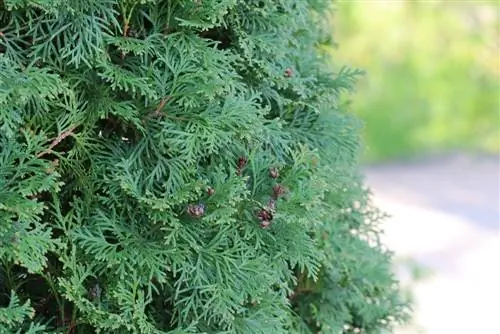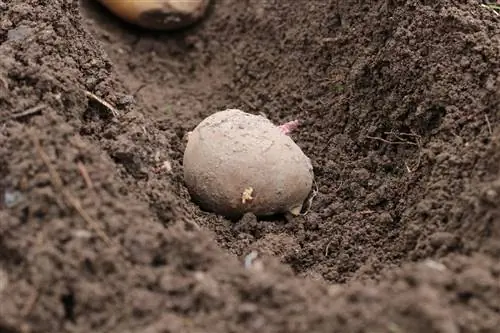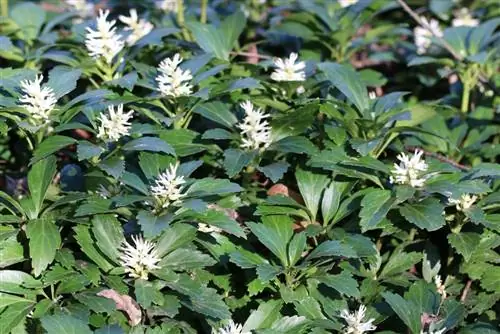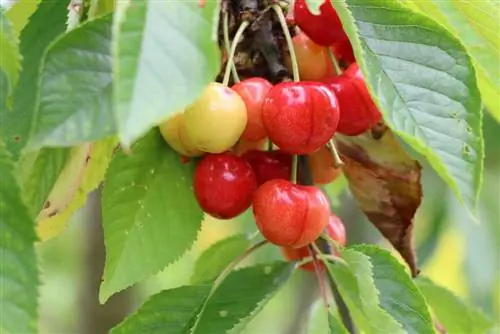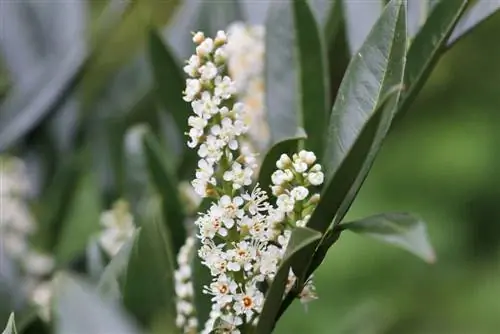- Author admin [email protected].
- Public 2023-12-17 03:39.
- Last modified 2025-01-24 12:45.
Most conifers are evergreen and are preferred for garden design because of this property. These are particularly popular as decorative plants in gardens and parks, especially among families, as these conifers do not sting. The easy-care conifers are opaque and are therefore ideal for creating hedges.
There are many different species with their own quality characteristics, the classics include yew, larch, fir and juniper. When planting, the timing, sufficient spacing and soil preparation are important.
Conifers
In German, the conifers are called conifers. Conifers are coniferous trees and belong to the botanical genus gymnosperms. The name gymnosperm is derived from the fact that the seed is completely exposed and is not surrounded by an additional ovary, as is the case with the gymnosperm. The following aspects are important for conifers:
- Fruits of these conifers are formed as cones
- it usually takes a few years for the cones to set in
- Mostly upright growth, main trunk runs straight through to the top
- only shed their needles every several years and are therefore considered evergreen plants
- year-round needle dress greens bare gardens in winter
- The exception is the native larch, which sheds its needles every year
- Larch trees also develop bright autumn colors before they drop
- Flowers mostly have no special meaning and have little decorative value
Time
Conifers should only be planted when the worst of the summer heat is over and it rains more often again. Then the mostly evergreen plants have enough time to form sufficient roots and grow well before winter. In addition, the conifers do not need to be watered continuously during this period, as frequent rainfall is to be expected. The following aspects should be taken into account when planting:
- best planting time is late summer to early autumn, end of August to end of September
- Spring is also suitable, shortly before or at the beginning of budding
- If it is extremely warm and dry for a long period of time in spring, water additionally
- basically almost any planting time in the summer months is possible
- However, during warm and rainy months the workload is much higher
Tip:
If the conifers are purchased as container plants with a finished root ball, they can be planted all year round. Frost-free and sunny days with no chance of rain are ideal for planting in winter.
Location & Soil Processing
Conifers do not have great demands on the site conditions as long as there is sufficient light. So that the conifers can grow well and take root quickly immediately after planting, the soil must be prepared accordingly:
- not particularly demanding, are happy with almost any location in the garden
- but thrive best in sunny locations
- as a solitary plant, possible in a group position or hedge
- Dig the soil at least two spades deep before planting
- remove weed roots directly
- ideally incorporate pre-fertilized potting soil
- add universal fertilizer to the soil
- then loosen the soil again until it is finely crumbly
- then plant the conifers
Tip:
The yews and the Siberian dwarf arborvitae also cope with damp places in the shade. Even if the garden area is rather dark and the soil is not sufficiently dry. However, waterlogging should never occur.
Distance & Plants
When planting, make sure there is a sufficiently large distance, as the conifers can grow very large and need a lot of space. If the conifers are planted as a hedge, the distance may be smaller. The following aspects should be taken into account when spacing and planting:
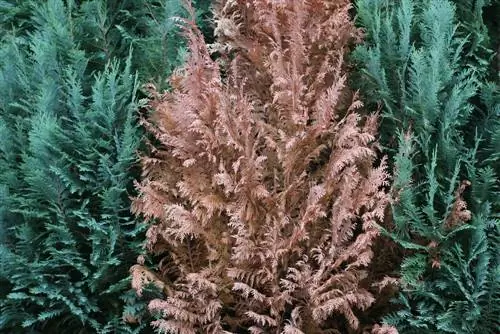
For large conifers, plan sufficient distance, at least 0.5-2 meters
- Always maintain planting distance, conifers should not touch each other
- as hedge plants they can grow closer together
- Create a planting hole twice as large as the root ball
- don’t plant too deep
- Smaller plants generally root better and quicker than large conifers
- the large species periodically stop growing
- Provide enough water regularly immediately after planting so that they root well
- larger specimens cope reasonably well with longer periods of drought
Tip:
If a thuja is planted, never let it dry out completely in the first three years of life! Otherwise, this conifer cannot settle in well and will not thrive.
Species diversity
Most conifer species are extremely easy to care for and are also evergreen. There are many different varieties to choose from, which can be optimally adapted to the prevailing site conditions:
- common and popular species in this country: yew, spruce, pine, fir, juniper, cedar
- more exotic species: arborvitae, primeval sequoia, cypresses
- Yew, pine and juniper grow well on dry soils and do not require much water in low-rain weather conditions
- Spruce, larch, false cypress, umbrella and helmeted fir, thuja need a little more moisture
- Yew trees are true survivors and can stand both dry and wet
- Waterlogging is generally not tolerated by all species
Watering, Fertilizing & Pruning
The conifers are relatively easy to care for and are not particularly demanding if the following care criteria are adhered to:
- Water conifers every now and then, never let them dry out completely
- water additionally in extremely dry weather conditions
- Stale rainwater is ideal
- Use fertilizer for coniferous plants
- most species are good for pruning
- Prune back before budding begins in early spring
- never cut into the old wood
- Yew trees can also tolerate radical pruning
Planting tips for hedges
Most gardens are decorated with hedge elements, which largely serve a practical purpose. Conifer hedges have a high decorative value, especially as a background in front of lush flowering flower borders:
- Hedge made of conifers serves as a replacement for a fence, as a structuring element in the garden structure and as a privacy and wind protection
- make a plan before planting the hedge and take environmental factors into account
- calculate the necessary distance to the neighboring property
- set maximum height and width, normal heights are approx. 1.8-2.5 meters
- shaped or wild-growing hedges are possible
- wild-growing hedge requires little to no care
- Cutting hedges should be monitored constantly and trimmed at least once a year
Conclusion
Conifers beautify any garden with their evergreen needles and are mostly very undemanding. Due to the great diversity of species, there is the right conifer for every property size, purpose and taste. However, before making a selection, the height and width should be compared with the existing site conditions, otherwise unpleasant surprises can quickly arise with excessive growth. The conifers are ideal for creating hedges that are extremely opaque and very easy to grow.
What you should know about conifers in brief
Conifers are available as evergreen or so-called deciduous plants - whichever type the (hobby) gardener chooses for planting, the weather conditions should always be taken into account first. For example, the young conifer plant doesn't like frost at all. It only plays a minor role whether the conifer is a container plant or a hedge plant. If the soil is too wet due to previous heavy rain, planting should always be postponed until a drier phase.
- When planting conifers, it is also important to pay attention to the correct distance from hedges, walls or house walls.
- In order to ensure truly he althy plant growth in this type of conifer, sufficient space in the root area is essential.
- The root system of a conifer must have the necessary space in the long term in order to guarantee a long lifespan.
Whether a conifer will actually grow after it has been planted and will grow long-term ultimately depends on the quality of the soil. Above all, this should be rich in humus and also have a loose texture.
- A clayey and relatively firm soil, on the other hand, prevents the sensitive roots of a conifer from growing he althily.
- Sooner or later it could even contribute to the roots becoming stunted and the plant ultimately threatening to die.
Hobby gardeners who plan to use one or more conifers in their home garden should of course also ensure adequate watering. If this is not done, there is a risk that the branches will soon become brown and unsightly - and the plant could therefore suffer significant damage.
- The best time to plant conifers is either in September or in the spring season, i.e. early April to late May.
- If the conifers are to be planted as a hedge, it is recommended not to use more than three to four plants per meter.
- The soil is previously hollowed out extensively around the roots and filled with water.
- The young plants are then planted.
Optimal lighting conditions are also important for the he althy growth of these plants: i.e. too little shade and excessively intense sunlight are not necessarily an advantage for a conifer in the long term.

